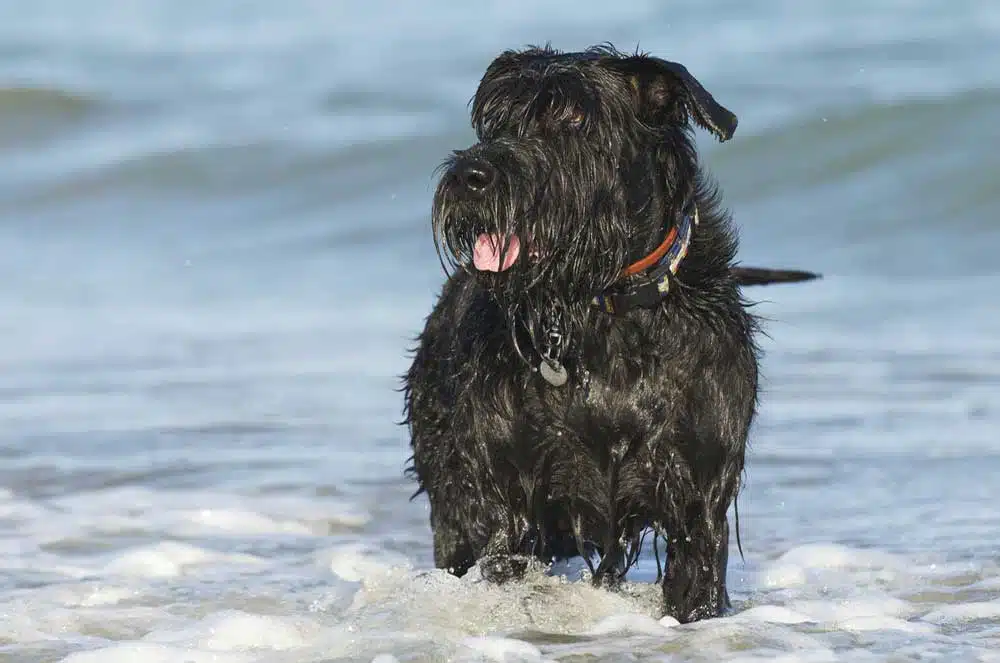
Are Schnauzers Hypoallergenic?
It’s a curse to be allergic to pets. The absolute torture, the torment, the unbearable urge to pet the cute fluffball in front of you, knowing that if you do, your allergies will spike. Is one quick heart-melting pet worth the stuffy nose and scratchy skin? Or no, should you resist?
When you’re allergic to man’s furry companion, this dramatic inner dialogue doesn’t seem too outlandish. For those of you who can relate to this (even to some degree), you may have wondered which dogs are safe to pet and which ones aren’t. Which camp do schnauzers belong to? To learn about this interesting breed attribute and more facts about schnauzers, read ahead.
Why Are Some Dogs Hypoallergenic?
While no dog is 100% hypoallergenic, there have been reports that people with pet allergies react less to certain breeds. The key is to find a dog that doesn’t shed as much as their counterparts. Despite the actual hairs not being what people are allergic to, if they shed hair, they’re likely shedding dander as well.
Dander causes the majority of standard allergic reactions in humans. It consists of microscopic skin flakes that become airborne and enter the eyes, nose, and respiratory tract of people, causing asthmatic symptoms. While it’s one major cause, there are other reasons why you may be allergic to your puppy:
- Pollen – Many people mistake an allergic reaction to their canine partners with a pollen allergy. Because dogs love rolling around in the grass and other plants, their fur becomes a vacuum for outdoor allergens. Once inside the house, they do the classic dog shake, releasing all these built-up particles.
- Saliva – There are proteins in a dog’s saliva that are harmless to the human body. However, some people’s immune system mistakes them for harmful particles, causing inflammation. This is what causes the sneezing, sniffling, and head stuffiness.
- Urine – Similarly, urine has the same proteins that can cause these reactions. While nobody is rolling around in their dog’s urine, that doesn’t mean your dog isn’t. These tiny particles can live on your dog’s fur and transfer to the couch, rug, or any other surface. From here, they easily become airborne.
Because all dogs have skin, saliva, and urine, no dog is truly hypoallergenic. However, some dogs naturally shed less dander, fur, and are generally easier to clean.
The Schnauzer
Onto the purpose of this article—let’s talk schnauzers. Schnauzers are adorably cute and often analogized to “old men” because of the way their beards hang down below their faces and their eyebrows grow over their eyes. When they bark, one can only assume they’re telling those young whippersnappers to get off their lawn.
There are three different breeds of schnauzer: miniature, standard, and giant, each bred with a specific purpose. What does each of these breeds hold for allergen-intolerant owners around the world? Let’s get to the bottom of the question: Are schnauzers hypoallergenic dogs?
- The standard schnauzer –The standard schnauzer lineage is known to go back to the 15th century when farmers were trying to breed a medium-sized dog to tend to the ranch. The schnauzer had a good temperament, was easily trainable, able to kill mice, and herd farm animals. Plus, the medium-sized dog was family-oriented and protective.
- A Hypoallergenic dog? With regular brushing, these dogs will remain mostly allergen-free.
- The miniature schnauzer – The miniature schnauzer (stunted growth schnauzer) was bred to catch and kill rats. Its smaller, slender body made it quicker and nimble enough to squeeze into narrow areas. Similar in temperament to the standard schnauzer, these small dogs are still considered today as one of the top ten ratters.
- Hypoallergenic? Shedding even less than the standard schnauzer, the miniature, stunted growth schnauzer only requires regular grooming and haircuts to remain a hypoallergenic dog.
- The giant schnauzer – Wanting to capitalize on one aspect of the standard schnauzer (the ability to herd farm animals), the giant schnauzer was bred in the mid-1800s. Because of their docile nature and their protective personality, giant schnauzers also made good family pets and police guard dogs in Europe. Today, they’re commonly found in showrooms and loving, family homes.
- Hypoallergenic? Drum roll please… also yes. Because these are bigger dogs—adult males weigh up to 90 lbs.—there is more fur to collect allergens. Be sure to groom and brush regularly to avoid allergic reactions.
Other Hypoallergenic Dogs
The schnauzers’ hypoallergenic quality isn’t contained to just one breed of dogs. There are plenty of other hypoallergenic dogs who are also perfect for those with pet allergies. Those dogs include:
- Bichon Frise
- Poodle
- Spanish Water Dog
- Maltese
- Kerry Blue Terrier
- Bedlington Terrier
- Afghan Hound
- Irish Water Spaniel
- Xoloitzcuintli
- Coton de Tulear
Common Allergy Symptoms
In the same way that dogs come with varying degrees of hypoallergenic-ness, people have varying degrees of reactions. You might have a friend who nearly has a panic attack at the sight of a dog or cat because their allergies are that intense. Or you might be that friend.
If you’re unsure whether you’re allergic to dogs, here are the common allergy symptoms:
- Itchy eyes – When dander settles on the eyelids or in the corner of your eyes, this can cause irritation. Be wary of itching your eyes. If you’ve recently pet a dog and the allergens are on your hands, this will ensure red, puffy eyes.
- Stuffy or runny nose – Similarly, when the dander settles in and around your nasal cavity, the same irritation will occur. Although it’s not clear why in some people it causes a runny nose and others a stuffy nose, both are part and parcel to the same allergic reaction.
- Headache – The headache usually results after one or more symptoms have appeared. Because the immune system is fighting off the invading particles, more blood is being sent to the eyes, nose, and head. This increased blood flow, when sustained, can cause a headache.
- Asthma, coughing, or sneezing – Once the particles become airborne, they’re small enough to breathe right into the lungs without realizing it. These can cause coughs or sneezes at the lesser end of the spectrum (or trigger an asthma attack on the upper end).
- Allergic dermatitis – For some people, just getting the dander or other allergens on the skin is enough to cause a skin rash. This could be in the form of itchy skin, red hives, or eczema.
This list of symptoms runs in no particular order. You could have one, two, or all of the symptoms listed above.
Complications from Allergen Exposure
Having a minor allergic reaction while you visit a friend who owns a dog is normal and not cause for an alarm. If you are severely allergic and a dog is brought into your home, however, there are complications that you should be aware of.
- Developing asthma – Asthma attacks constrict the muscles around the throat and airways, decreasing the amount of oxygen you can breathe in. In cases where the allergies are constant and always present, this can develop into asthma, which comes with severe reactions.
- Sinus infection – Because of the constant inflammation of the nasal passageways, the obstructions can allow bacteria to settle and cause an infection. This will have to be treated with antibiotics or a nasal spray.
Living with a Dog Despite Being Allergic
If you’ve recently adopted a dog and found out that you’re allergic, it doesn’t mean you have to return them to the shelter. It is possible to live with a dog despite being allergic. Of course, if your health is at risk, you may be forced to give them up or find another loving home.
Before you do that, here are some tips for minimizing the allergic reactions to a dog breed:
- Regular grooming – Because dander, pollen, mold spores, and other allergens are collected on the fur, be sure to groom your dog regularly. Try keeping their hair short (although, talk with a vet or professional dog groomer about how short—remember that a dog’s fur is their warmth through the winter and at night). Grooming includes brushing, trimming, and baths.
- Keep your dog outside – Plenty of dogs live outside. Give your dog a comfortable doghouse, the best food for Schnauzers, and plenty of loving time during the day to ensure they’re happy.
- Set boundaries in the house – It’s also possible to contain the allergens as much as possible. Don’t let your dog in the bedroom in order to avoid allergic reactions while you sleep.
- Daytime allergy medication – If the reactions are only minor, and over the counter allergy pill might be enough to contain your allergies. Be sure to find one that’s non-drowsy to avoid falling asleep at your desk!
- Avoid petting your puppy and then touching your face – Unless you contact dermatitis from petting your dog, feel free to pet them and give them some love. Before you touch anything else, however, immediately wash your hands and forearms with soap and water to avoid spreading the pet dander.
Schnauzers: The Perfect Pet
Not only are schnauzers hypoallergenic, but they’re also incredibly warm and friendly dogs, eager to please, and easy to train. If you’re looking for a good companion with relatively few health issues or looking for a family dog who will love and protect your children, the schnauzer is the perfect pet.
Plus, if you have any rat issues, they can help with that too.
Sources:
AAFA. Pet Allergy: Are You Allergic to Dogs or Cats? https://www.aafa.org/pet-dog-cat-allergies/
Mayo Clinic. Pet allergy. https://www.mayoclinic.org/diseases-conditions/pet-allergy/symptoms-causes/syc-20352192
10 Interesting Facts About Schnauzers. https://www.lucypetproducts.com/blog/10-interesting-facts-about-schnauzers
A Helpful Guide to the Best Food for Schnauzers. https://www.lucypetproducts.com/blog/a-helpful-guide-to-the-best-food-for-schnauzers
6 Common Schnauzer Health Problems. https://www.lucypetproducts.com/blog/6-common-schnauzer-health-problems







Leave A Comment
You must be logged in to post a comment.